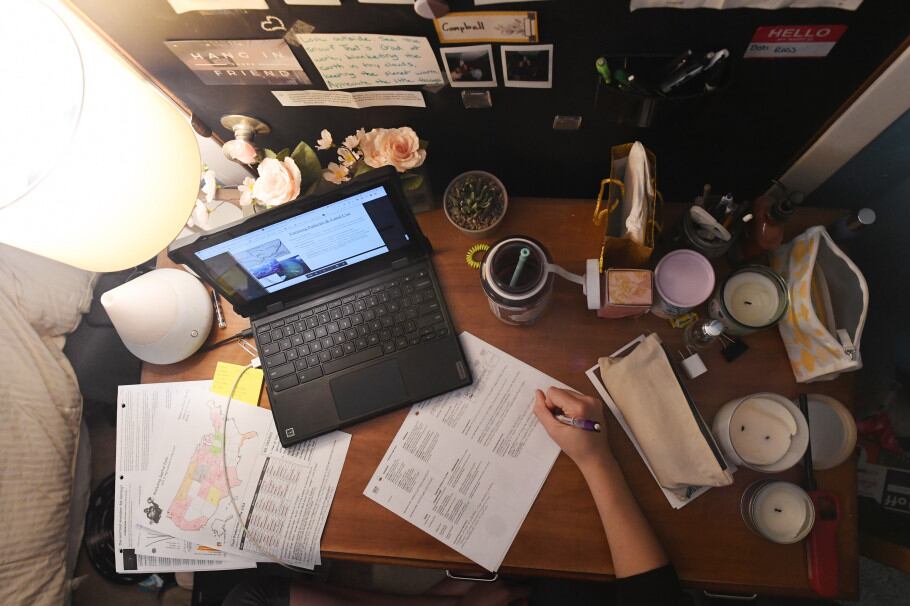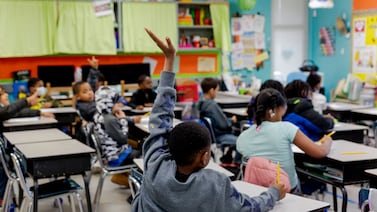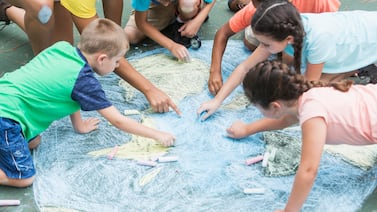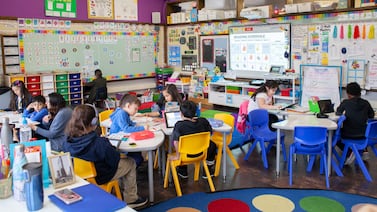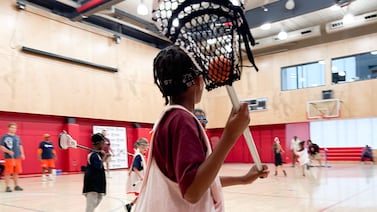Students at nearly all of Denver’s large high schools will continue to learn completely virtually through the end of the calendar year, even after campuses reopen next month.
The reason is not because schools find virtual learning to be better than face-to-face learning. Rather, it’s largely because the district has placed strict limits on in-person interactions between students and teachers in an attempt to minimize the spread of COVID-19.
South, North, George Washington, Thomas Jefferson, John F. Kennedy, Abraham Lincoln, and Northfield high schools will continue remote learning for the second quarter, which starts Oct. 21 and ends in late December. All of those schools serve more than 900 students each. Students will have the opportunity to go to campus for in-person support, but classes will taught virtually.
Denver’s largest high school, 2,500-student East High, is the exception. Students at East will have access to six hours per week of in-person classes, thanks to a new block schedule the school put in place at the start of the school year in anticipation of such a situation.
“What a school began doing in August creates the reality of what they’re able to do right now,” said East Principal John Youngquist.
He stressed that schools are working within the parameters set by their districts, which differ across county lines.
“Whether parents like or don’t like what a school is doing, I want people to understand everything is in response to the direction of a district,” Youngquist said.
Denver Public Schools is admittedly being conservative. After consulting with local public health officials, the district decided to limit the number of classmates each student can interact with to 35. Teachers are limited to interacting with 70 students each.
Those restrictions may allow elementary schools to operate close to normally. But high schools are different. High schools can’t run a typical schedule of students rotating to seven classes each day, with seven sets of classmates and teachers.
Even a hybrid schedule with a mix of in-person and virtual classes would expose teachers to too many students. A single sick student who has contact with seven teachers can send those teachers into quarantine at home. That means the rest of the teachers’ students — in some cases, hundreds of kids — have to learn from home too.
That scenario, which has played out in other Colorado districts, is one Denver wants to avoid.
“We felt like going with these more conservative numbers at the lower end would safeguard our time in school, would limit the amount of exposure — both students with each other, as well as our staff with our students — and would give us the greatest opportunity to safely reopen and keep kids in school,” Superintendent Susana Cordova said recently.
Dr. Bill Burman, director of Denver Public Health, said there are additional considerations in Denver that led to a more cautious approach. The map of COVID in Denver is largely the map of poverty. When his department did modeling of how frequently schools would be expected to close for quarantine, schools in high-poverty neighborhoods were more heavily affected.
Burman said that map had a “significant impact” on the district’s decision-making. However, he doesn’t think Denver has a dramatically different philosophy than other districts that opened secondary schools with more normal schedules and larger cohort sizes.
“There are relevant differences across school districts that lead to different decisions even when the underlying philosophy is the same,” he said. “I think the district is being appropriately cautious in a rapidly changing pandemic.”
But Cordova acknowledged that Denver’s cautious approach has caused scheduling challenges for middle and high schools. Principals suspect those challenges could be one reason why district data shows only 56% of secondary students have chosen in-person learning for the second quarter, compared with 69% of elementary students.
To make in-person learning happen at East, the school had to completely change its schedule. Instead of offering seven courses each semester, East is now splitting the school year into quarters and offering four courses one quarter and three courses the next.
The school also split its students into two groups: morning and afternoon. Half the students get real-time instruction in the morning and do schoolwork on their own in the afternoon, and vice versa. That way, teachers teach about 15 students at a time instead of 30.
East chose the schedule because it can be applied both remotely and in person, Youngquist said. Starting Oct. 21, students who chose classroom learning will go to East two days per week to do their real-time learning in person. The other days will remain virtual.
There are some downsides to block scheduling, though. The biggest is a loss of continuity: Instead of taking 45 minutes per day of math all year long, students may have math first and third quarter for 90 minutes per day. Such on-again, off-again can be difficult for students who struggle, as well as for those preparing to take Advanced Placement tests.
Northfield Principal Amy Bringedahl said her school stuck with a seven-classes-per-semester schedule for just that reason. Bringedahl said she and her team also assumed the number of students allowed to interact with each other — often called a cohort — would be larger, thereby allowing some in-person learning. But with cohorts of 35, it’s not possible.
“For us, that is the biggest barrier and challenge we face,” she said.
Instead, Northfield students will continue taking their classes virtually. The school is trying to figure out how to bring students back to campus for social and emotional support.
In the meantime, Northfield has welcomed back a small number of students who had trouble connecting to the internet at home. The students do their virtual learning while being supervised by non-teaching staff. Of the 37 students invited to attend, Bringedahl said 16 accepted. But only 10 or 12 students attend regularly, she said.
“It’s difficult for kids to sit in a classroom all day and do virtual learning,” she said.
Erica Meltzer contributed to this report.

